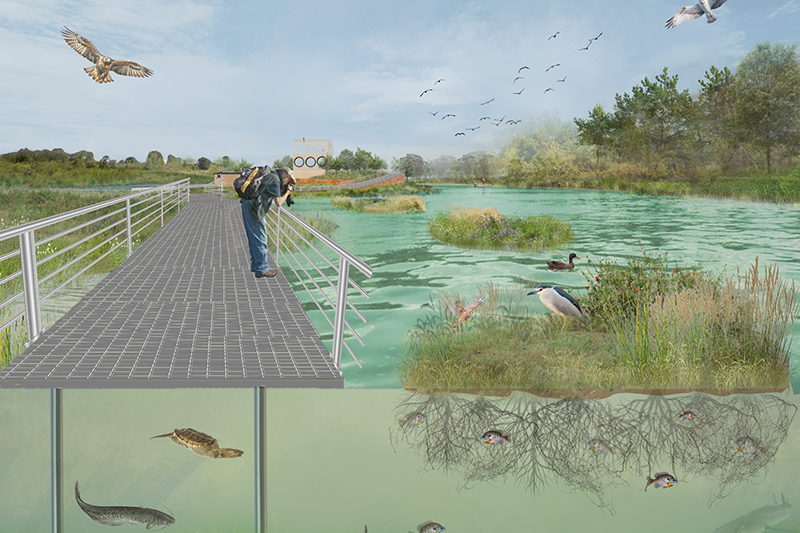


Design for resilience
Photos courtesy of Bri Egan, Cate Boettger and Talia Brinker January 06, 2025
Landscape architecture students work with the Coastal Resilience Design Studio on a plan for Milton
Like much of Sussex County, Milton, Delaware, is on the cusp of significant development. But what makes Milton attractive also makes it vulnerable.
Located at the head of the Broadkill River, which runs 13 miles from Wagamons Pond to the Delaware Bay, Milton is one of many coastal communities susceptible to sea level rise and to surges from increasingly intense storms.
Over the summer, landscape architecture majors Bri Egan, Cate Boettger and Talia Brinker worked as undergraduate Community Engagement Summer Scholars with the Coastal Resilience Design Studio (CRDS) on a community resilience plan for Milton.
A partnership between three University of Delaware programs — the Delaware Sea Grant College Program, Sustainable Coastal Communities Initiative, and the Landscape Architecture Program — CRDS selects cities and towns throughout Delaware to consider solutions for issues identified by the community.
The students worked on interdisciplinary teams that addressed the three branches of the Milton plan: stormwater management, wildlife habitat loss, and community connection through hiking and biking trails.
Though each team addressed a unique concern, “it's hard to move forward if you're not considering the other groups,” said Egan, a senior working with the downtown team. “It’s all very interconnected.”
Working with other disciplines is all part of the experience. CRDS Director Zach Hammaker, who is also an assistant professor of landscape architecture, said that students “learn someone else's professional language to be able to communicate in a productive way.”
“We push the researchers and scientists to get involved in the design process,” Hammaker said. “And they're helping the designers on the team make sure that their design recommendations will function and meet the goals that they're putting forward.”
Putting together a plan
The students kicked off the project with what Hammaker calls the “immersive experience” — meeting town leaders, viewing key locations, and hearing from the public in the community where the study is taking place.
“You have to know your audience well,” said Boettger, a junior from Newark working on the trails team.
”We're trying to really capture as many voices as we can,” said Hammaker, noting that CRDS has worked with smaller, bayside towns for the last two summers.
Residents identified where they live, reported flooding hotspots, shared their favorite locations, and described what the town means to them.
Using this community input, the team identified cost-effective, high-impact projects that can address concerns that come to light. Often, the team proposes solutions that meet many needs.
Brinker, a senior from Hockessin, is part of the team working on stormwater management.

“We'll propose the trail system to conserve land, to widen the flood plain and to keep it forested, because forested areas slow and absorb water,” she said.
In turn, trails planted with native species serve as ecological connectors — pathways that bridge fragmented habitats. Pedestrian- and bike-friendly trails that link popular locations reduce the traffic demand on local roads.
“You can make a healthier and safer community with more trail connectivity,” Hammaker said.
Milton mayor John Collier was pleased with the students’ work from start to finish.
“The engagement from the students with the community and the town leaders was outstanding,” Collier said.
The team presented recommendations to town leaders in August. Presenting to the community was a learning experience for the students.
“You have to be gentle with introducing unfavorable information, especially to folks who have lived in the same town their whole life,” Boettger said. “Even good news may not be what people want to hear. So introducing it in a neutral light with extensive research to back it up is the way to go.”
Implementation of the plans is unique to the community’s needs and resources.
The community resilience plan for Slaughter Beach led to the town being selected for direct technical assistance from the Federal Emergency Management Agency (FEMA).
“They gave us a lot of food for thought,” Collier said. “Now I have a target to work with, to seek funding.”
About Community Engagement Summer Scholars
Community Engagement Summer Scholars Scholars spend 10 weeks during the summer immersed in a community-based research or creative project under the direction of a faculty mentor. Undergraduate students in any major are invited to apply to become a 2025 Community Engagement Summer Scholar through March 10, 2025. The program is open to all undergraduate students and is administered by the Community Engagement Initiative, which works to facilitate and strengthen UD’s identity and impact as an engaged research university and community partner throughout the state of Delaware and beyond.
Contact Us
Have a UDaily story idea?
Contact us at ocm@udel.edu
Members of the press
Contact us at 302-831-NEWS or visit the Media Relations website

